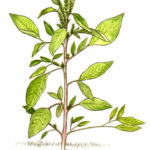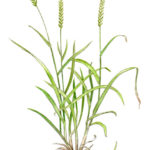The Hit List
These are the weeds we love to hate.
By Becky Mills | Photos By Ray E. Watkins, Jr.
Canada Thistle
Canada thistle is a weed that could easily make the most hated list. It is aggressive. Horizontal roots can reach out 15 feet or more, while vertical roots can grow 6 to 15 feet deep. If that isn’t enough, it can reproduce by seeds too, and the little buggers can remain viable up to 22 years.
Canada thistle tends to show up where the soil has been disturbed by tillage or overgrazing. Livestock try not to graze near it, so it can really hurt pasture productivity.
Generally, a multi-pronged approach is needed to get rid of the weed, and persistence is key. Think fertility to keep your hay crop or pastures in top shape so they can help crowd it out, but go easy on the nitrogen because it can actually help the thistle.
As for chemical control, picloram, aminopyralid, clopyralid, dicamba and chlorsulfuron will work, but it may take re-treatment for one to three years or more.
Spiny Pigweed
Spiny pigweed, a.k.a. Spiny Amaranth, kicks your pastures when they’re down. The nasty summer annual loves overgrazed pastures and seems like the only plant that can thrive in a drought.
An overachiever, the weed can grow up to 4½ to 5 feet tall. Spiny pigweed also can accumulate nitrates, although most livestock won’t eat it unless they are desperate.
To control it, the obvious answer is to not overgraze. But that is much easier said than done when pasture is scarce.
Mowing can knock it back, but the weed will regrow if you don’t keep at it. Herbicides can help too, but they usually need to be applied when the weeds are less than 4 to 6 inches high. Plus, it is hard to kill pigweed without getting your clover too.
The best bet is to lime, fertilize and rotationally graze so your pastures stay in good shape. And pray for rain.
Cheatgrass
Cheatgrass, or downy brome, is an aggressive, invasive winter annual that can produce more than 10,000 plants per square yard. Its main claim to infamy is it displaces native grasses and is highly flammable, making controlled burns difficult and wildfires a threat.
Disking can help if it is timed right. Disk in the spring and fall before the seed heads turn purple, then do it again when new plants appear. Or, if you are planning on planting a hay crop or pasture in the fall, disk once late in the spring and bury the seeds at least 3 inches deep.
Don’t bother to mow; the plants will just make more seeds.
If cheatgrass is a problem in your pastures, you can graze it like crazy twice in the early spring, three weeks apart when the grass is green but before it makes seed. You’ll need to do that at least two years in a row.
Chemical control also can work, but make sure you check the labels first.
As for controlled burns, unless you are very experienced, don’t try it without expert help. Since cheatgrass is so flammable, a controlled burn can turn into an out-of-control wildfire in no time.
Quackgrass
If alfalfa growers had a least wanted list for weeds, quackgrass would probably be at the top. A perennial with an aggressive root system, it can grow to 3½ feet tall and can take over large patches of a field. “Once it is established, most herbicides don’t adequately control it,” says Steve Orloff, county Extension director for Siskiyou County, Calif.
Orloff recommends Roundup Ready (glyphosate-tolerant) alfalfa. “Quackgrass has not been an issue in Roundup Ready alfalfa because the weed never has a chance to get established. Control is much more problematic in conventional alfalfa.”
He emphasizes: “The best way to control quackgrass is prevention. Treat it prior to planting alfalfa so it takes longer to invade the field [after the planting] and then spot-treat with a selective grass herbicide to prevent it from becoming well established.”
Exporters Beware
Dairy producers and horse owners in Japan, Korea and the United Arab Emirates welcome Bill Littler’s timothy hay. His weeds, not so much.
“There are weeds they will not accept for export,” says the Troy, Idaho, grower. The list starts with wheat. Although it is a welcome grain crop in most places, Littler says the danger of importing the hessian fly with the wheat keeps it on the bad list for his export customers.
“Wheat can be a problem in a first-year seeding,” he says. “If I do have it in my timothy, I sell it to a different customer.”
Resources
For more information on weed control, check out the following websites:
Weed Identification
www.aragriculture.org/forage_pasture/plant_id/weeds/
Toxic Plants in Forages
www.extension.purdue.edu/extmedia/ws/ws_37_toxicplants08.pdf






